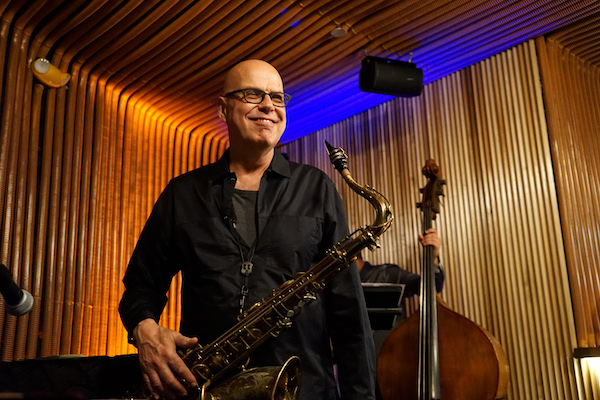Apr 2, 2024 12:59 PM
Saxophonist, Sonic Explorer Casey Benjamin Dies at 45
Casey Benjamin, the alto saxophonist, vocalist, keyboardist and producer who stamped his distinctive sounds on the…

Bob Sheppard says he’s “probably done everything there is to do in the music business.”
(Photo: Courtesy of Artist)As one of the most in-demand horn players in Hollywood, saxophonist Bob Sheppard has appeared on albums by Steely Dan, Neil Young, Joni Mitchell and Michael Bublé. Sheppard’s gun-for-hire skills have paid off well since he arrived in Los Angeles during the mid-1980s, but at the cost of getting his own name on the show calendar.
The New Jersey-born musician has released only four albums under his own name, but he’s looking to make up for some of that lost ground. His most recent dispatch, The Fine Line (Challenge), features small-ensemble writing and strong solo work from Sheppard, who surrounds himself with longtime friends and a few new faces.
“The creative culmination of writing and playing and getting the energy of people together to do it, it brought me alive,” said Sheppard, surrounded by an army of mouthpieces and a travelogue of backstage passes in the small studio behind his house, a sanctuary located within shouting distance of nearly every major film and television studio in Los Angeles. “I’ve played with great people. I’ve probably done everything there is to do in the music business at this point, but the most important thing for me is to play jazz and get better.”
Across 10 tracks, Sheppard traverses a lot of ground. He wrote half the compositions on The Fine Line; the rest of the album consists of contributions from his bandmates and a couple standards. The Sheppard-penned album opener, “Edge Of Trouble,” features vibraphonist Simon Moullier, whom Sheppard met one night during a jam session at L.A.’s Blue Whale.
“He knocked me out,” Sheppard said. “I hadn’t recorded with vibes before, and it turned out to be a nice mix. He’s a guy who plays his ass off and knows exactly what he wants.”
He and Moullier fly about in sprightly unison, Sheppard comfortably exerting his soprano saxophone, which he returns to frequently, including on a swinging waltz through the Rodgers and Hart standard “I Didn’t Know What Time It Was.”
Sheppard compiled his rhythm section for the sessions by enlisting Dutch bassist Jasper Somsen, who appears on the album using Ray Brown’s old bass on loan from John Clayton, and drummer Kendrick Scott, the young Houston-born powerhouse who started the year playing with saxophonist Charles Lloyd.
John Beasley, who first met Sheppard in the mid-’80s when the two were members of Freddie Hubbard’s band, holds down the piano chair. Sheppard is a prominent soloist with Beasley’s MONK’estra, a large-ensemble homage to Thelonious Monk.
“It’s great to see him evolve as a writer,” Beasley said of his bandmate. “People kind of sleep on his writing. But he’s not so precious with his music. He allows guys to bend it and be expressive with it like all the greats do. He’s a great tenor sax player, but he’s a really good lead player, too. When it’s on my gig, I can point to him at any time during the show and just say, ‘Go!’”
Sheppard’s reasons for neglecting his solo career are understandable. It often pays much better to work on an hourly basis on a soundstage than to spend time polishing one’s own vision. And gigs playing with late-night TV orchestras and recording commercial jingles often have come looking for Sheppard.
“Left to my own devices, I sort of sit around and write on the piano and practice tunes and I go to gigs,” Sheppard said. “Years go by doing that. When I was writing this record, I said to myself, ‘This is what I should be doing now.’ It’s a different perspective writing music and then trying to record it.”
Sheppard sometimes underplays his own accomplishments, passing off his incredible versatility and dependability as run-of-the-mill. But he seems ready to push harder for his own spot on the marquee: “The path that I took was the one of least resistance,” he said. “Being a leader is the most difficult thing to achieve. It’s all on you and it requires a single-mindedness about your desires. There is no one who respects that more than I do.” DB

Benjamin possessed a fluid, round sound on the alto saxophone, and he was often most recognizable by the layers of electronic effects that he put onto the instrument.
Apr 2, 2024 12:59 PM
Casey Benjamin, the alto saxophonist, vocalist, keyboardist and producer who stamped his distinctive sounds on the…

“He’s constructing intelligent musical sentences that connect seamlessly, which is the most important part of linear playing,” Charles McPherson said of alto saxophonist Sonny Red.
Feb 27, 2024 1:40 PM
“I might not have felt this way 30 to 40 years ago, but I’ve reached a point where I can hear value in what people…

Albert “Tootie” Heath (1935–2024) followed in the tradition of drummer Kenny Clarke, his idol.
Apr 5, 2024 10:28 AM
Albert “Tootie” Heath, a drummer of impeccable taste and time who was the youngest of three jazz-legend brothers…

“Both of us are quite grounded in the craft, the tradition and the harmonic sense,” Rosenwinkel said of his experience playing with Allen. “Yet I felt we shared something mystical as well.”
Mar 12, 2024 11:42 AM
“There are a few musicians you hear where, as somebody once said, the molecules in the room change. Geri was one of…

Henry Threadgill performs with Zooid at Big Ears in Knoxville, Tennessee.
Apr 9, 2024 11:30 AM
Big Ears, the annual four-day music celebration that first took place in 2009 in Knoxville, Tennessee, could well be…